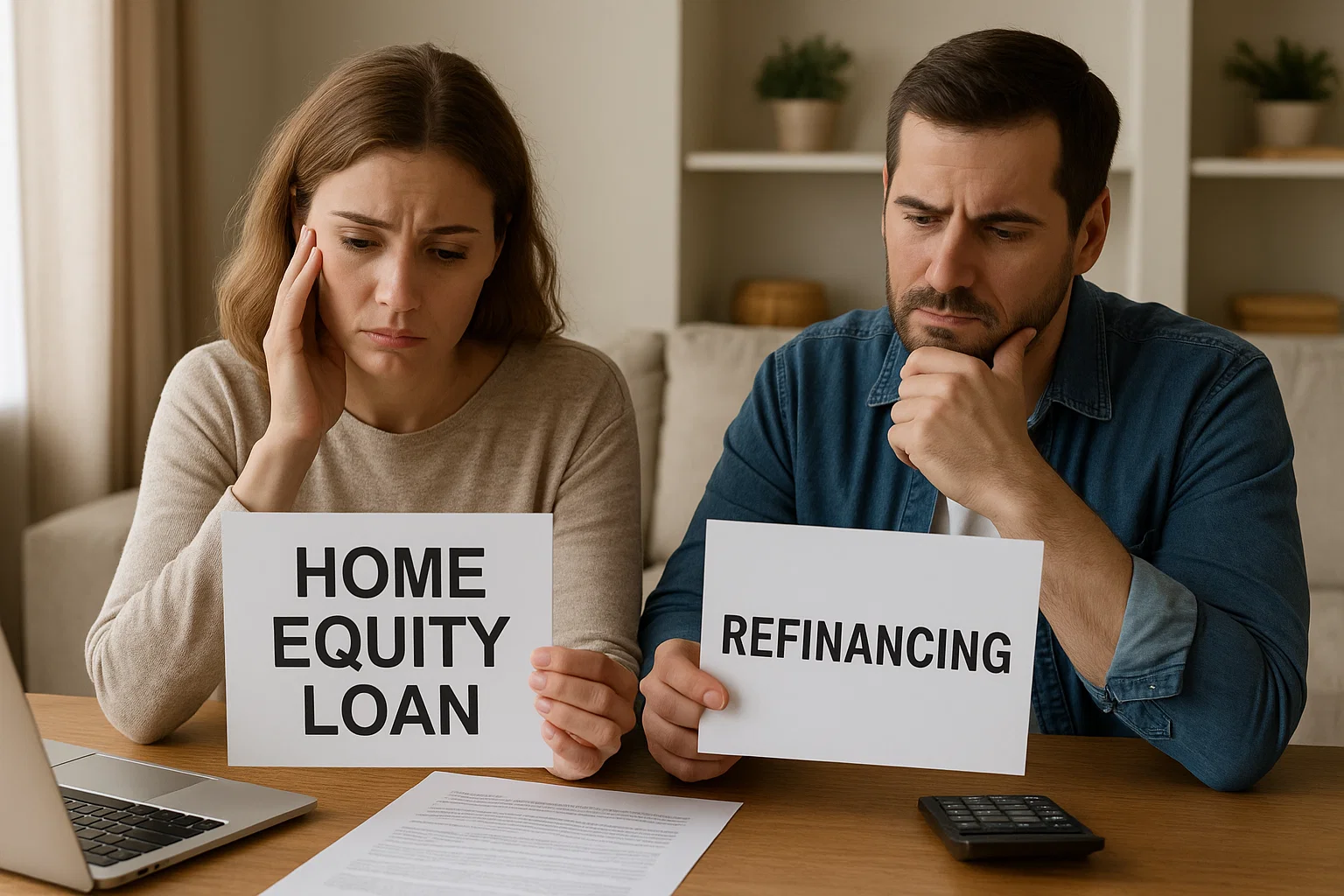.png)
Homeownership involves countless decisions, but few are as consequential as choosing between predictability and flexibility in your mortgage structure. While an adjustable-rate mortgage (ARM) might initially seem attractive due to lower initial rates, reduced monthly payments, and savings in early years, this initial comfort can morph into anxiety about unpredictable payment increases and budgeting uncertainty as adjustment periods approach and market conditions shift.
For homeowners navigating the complexities of ARMs, refinancing to a fixed-rate structure offers a pathway to long-term stability and peace of mind. Knowing when and how to make this transition can transform your mortgage from a source of stress into a reliable, manageable component of your financial foundation.
Understanding the Adjustable vs. Fixed Rate Distinction
An ARM operates in two distinct phases: an initial fixed-rate period, typically lasting three to ten years, followed by periodic adjustments based on market benchmark rates. During the introductory phase, borrowers enjoy lower interest rates compared to fixed-rate alternatives, resulting in reduced monthly payments and immediate savings.
However, once this initial period concludes, the interest rate adjusts—usually annually or semi-annually—according to prevailing market conditions and specific benchmark indices. Particularly in rising rate environments, these adjustments can substantially increase your interest rate, leading to higher monthly payments that strain household budgets and complicate financial planning.
Fixed-rate mortgages eliminate this variability entirely. Your interest rate remains constant throughout the loan's entire duration, whether it is fifteen, twenty, or thirty years. This consistency ensures your monthly principal and interest payments never fluctuate, transforming budgeting from guesswork into predictable planning.

The refinancing process to convert from adjustable to fixed rates resembles obtaining a new mortgage: you work with lenders to evaluate your financial profile, submit updated documentation, arrange a property appraisal, and close on your new fixed-rate loan. Conversion fees and closing costs typically range from 2–4% of the loan amount, though many borrowers believe the long-term stability justifies these upfront expenses.
Essential Questions Before Converting
Before committing to a conversion, critical questions must be addressed:
- When does your adjustment period begin? Refinancing before your first or next rate adjustment maximizes savings and avoids payment increases.
- How much could your rate increase? Review your loan agreement's adjustment caps and calculate potential payment changes to fully understand your exposure.
- How long will you remain in your home? Fixed-rate refinancing is most beneficial when you plan to stay long enough to recover closing costs through payment stability.
- What are current fixed rates versus your adjusted rate? If fixed rates are lower than your anticipated adjusted rate, conversion delivers immediate and ongoing savings.
When Refinancing to Fixed Rates Creates Value
The most compelling scenario for conversion occurs when you are approaching or have entered your adjustment period and market rates have risen or are expected to rise. Homeowners who secured ARMs during low-rate environments may face dramatic payment increases as their loans adjust to current market conditions.
For example, a borrower with a 5/1 ARM who secured an initial rate at 6% might see adjusted rates push up to 8–9%. This could increase their monthly payment by ₹10,000–15,000 or more, depending on the loan size. Refinancing to a fixed rate at 7.5% before that adjustment locks in predictability while avoiding the highest adjusted rates.
Career and life stage transitions also drive conversion decisions. Homeowners approaching retirement often prefer fixed payments that remain constant as income shifts from salary to pension or investments. Families with growing children benefit from payment predictability that simplifies long-term planning.
Financial peace of mind is another powerful motivator. Even if your adjustable rate might theoretically decrease in certain market conditions, the inherent uncertainty creates stress. Fixed-rate refinancing eliminates this mental burden, transforming anxiety into confidence.
Refinancing to fixed rates also allows homeowners to adapt their mortgage to their actual circumstances, especially if original assumptions—such as planning to sell or refinance before adjustment periods began—did not materialize.
Calculating Your Conversion Benefits
Real numbers help clarify whether fixed-rate refinancing serves your situation. Consider Priya from Bangalore, who has a ₹50 lakh adjustable-rate mortgage at 7% (₹37,000 monthly) nearing her first adjustment. Based on current market indices, her rate could adjust to 8.5%, increasing her payment to approximately ₹42,500—an additional ₹5,500 monthly, or ₹66,000 annually.
If she refinances to a fixed rate at 7.8% for the remaining term, her payment becomes approximately ₹39,500. This is higher than her current payment but ₹3,000 less than her adjusted payment would be, and that payment remains stable for the loan's duration regardless of future market fluctuations.
If her refinancing costs are ₹1.5 lakh, she recovers these costs in roughly four months based on the ₹3,000 monthly savings compared to the adjusted rate. Beyond that break-even point, every month represents savings while eliminating the risk of further rate increases. Over ten years, she could save ₹3.6 lakh or more compared to remaining with adjustable rates in a rising rate environment.
Alternatively, if Priya's current rate is 7% and she can secure a fixed rate at 6.5%, she achieves immediate savings while locking in long-term stability—the best-case scenario. Even when facing a potential slight increase (e.g., from 7% to 7.8%), the certainty of the fixed rate often outweighs the gamble of potential future decreases under an ARM.
It is advised to use online calculators to model your specific situation, comparing your current payment, projected adjusted payments, and available fixed-rate payments to see exact savings and stability benefits before committing.
Critical Considerations for Rate Conversion

Before moving forward, evaluate the following:
- Prepayment Penalties: Review your existing loan for fees associated with early closure, as these might reduce refinancing benefits.
- Lender Comparison: Fixed-rate offers vary significantly; shop around thoroughly for the most competitive terms across multiple lenders.
- Break-Even Timeline: Calculate realistically when refinancing savings will offset closing costs and ensure you will remain in the property beyond that point.
- Shorter Terms: Consider fifteen-year fixed-rate mortgages, which offer even lower interest rates than thirty-year terms, provided you can manage the higher monthly payments.
- Financial Profile: Assess whether your credit score has improved since the original loan, which might unlock more favorable fixed rates.
Building Your Conversion Strategy
Refinancing is about proactively managing your largest financial obligation to align with your long-term goals and risk tolerance—it is not about reacting impulsively to adjustment notices. Start by clearly understanding your current loan terms: when the rate adjusts, what the adjustment caps are, and what indices determine your new rate.
Research current fixed-rate offerings from multiple lenders, including traditional institutions and digital-first platforms. Seek lenders who are transparent, clearly explain all costs, provide detailed comparisons, and do not pressure rushed decisions, as converting your mortgage structure is a significant financial commitment deserving careful consideration.
Partner with lenders experienced in rate conversions who understand the unique concerns of adjustable-rate borrowers. The right institution will help you model various scenarios and calculate genuine break-even timelines to ensure the conversion delivers actual value.
In today's evolving interest rate environment, where economic uncertainty challenges the prediction of future rate movements, fixed-rate refinancing provides homeowners a powerful tool for financial stability. Ensuring your largest monthly obligation remains predictable directly impacts your overall financial health and planning capability.
Approach conversion with discipline: calculate break-even points realistically, compare offerings thoroughly across multiple lenders, and align decisions with your actual housing timeline and financial priorities. When executed strategically, refinancing transforms uncertainty into stability, anxiety into confidence, and unpredictable payments into reliable financial planning.
Take control of your mortgage structure by evaluating your adjustment timeline and researching fixed-rate terms. The power to eliminate rate uncertainty exists; it simply requires the initiative to investigate whether today's conditions and your circumstances favor making that stabilizing move.

Alex Chen

Alex Chen













Get in touch with a loan officer
Our dedicated loan officers are here to guide you through every step of the home buying process, ensuring you find the perfect mortgage solution tailored to your needs.
Options
Exercising Options
Selling
Quarterly estimates
Loans
New home

随时了解有见地的文章和指南。
每周一,你将获得一篇文章或指南,这将帮助你在工作和个人生活中更具活力、更专注和更有成效。





.png)
.png)
.png)
.png)
.png)
.png)
.png)
.png)
.png)
.png)
.png)
.png)
.png)
.png)
.png)
.png)
.png)
.png)
.png)
.png)
.png)
.png)